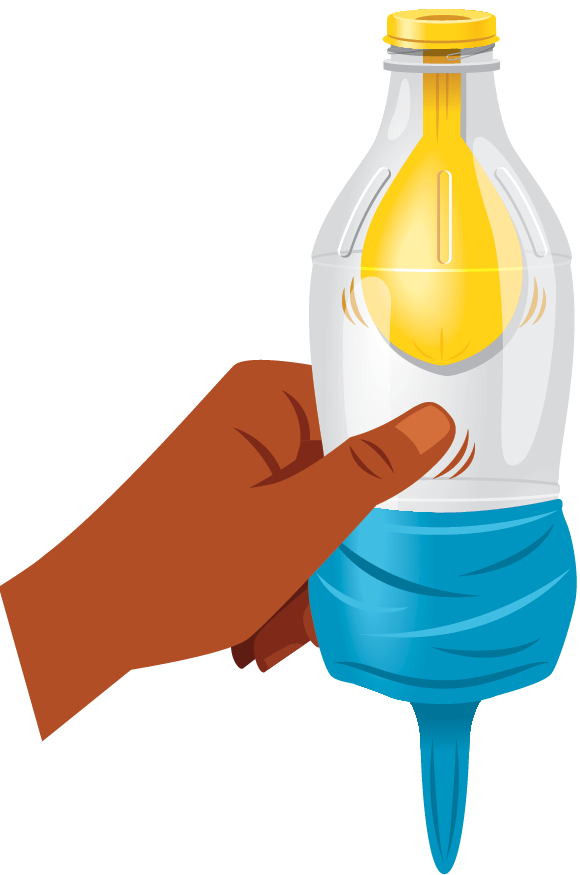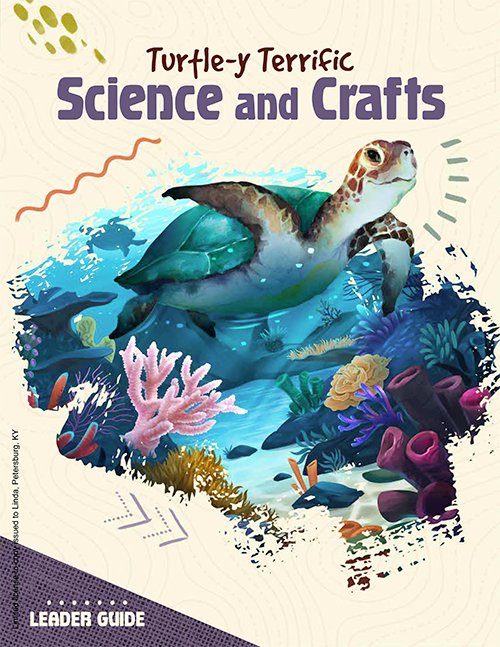Let's Get "A-Lung"
Day Four Experiment
on November 24, 2021
Materials
LATEX WARNING: For any student with a latex allergy, prepare a model using non-latex gloves in place of balloons and place them at a latex-free table. If the allergy is severe, consider doing a different experiment.
- Lungs Picture
- Round latex balloons, 2 per child or group
- Stiff plastic bottles, like Powerade or Vitamin Water, 1 per child or group
- Scissors, 1 per child or group
- Optional: electrical tape, 1 piece per child or group
Pre-Prep
Decide if you are completely making these ahead of time, or having the students do part of the assembly. (See the Tip Corner.) Cut off the bottom of the bottle (the opposite end from the opening), about an inch from its base. Lower one balloon into the inside of the mouth of the bottle and fold the opening of the balloon over the rim so the balloon hangs on its own. If the seal around the rim of the bottle isn’t tight, seal it with electrical tape.
Tie off the open end of the other balloon (the bottom) and cut off the top quarter. Stretch the cut end of the balloon around the cut end of the bottle and pull it tight so it has a good seal. Secure it with electrical tape if needed. Note: If the cut edge of the bottle is sharp or rough, cover with tape to protect the balloon.
Class Time Directions and Dialogue
On the count of three, let’s all take a deep breath. Ready? 1-2-3. Do so.
Why do we need to breathe? Take responses. We have to breathe because we need to get the oxygen that’s in the air to the trillions of cells that are in our bodies.
Read Genesis 2:7. So right from the start, we needed to breathe.
God is the one who gives us breath. We can thank him for each breath and for each day he gives us. Each one is a gift from him and for him. Someday, we’ll get to our last breath. I hope you have received the gift of eternal life with our Creator by repenting of your sin and putting your faith in Jesus!
Hold up the Lungs Picture. Okay, so here’s how God created our lungs to operate. When we breathe, air goes in through our mouth or nose. Let’s breathe to try it! Do so. Then it goes down through our larynx, trachea (have them gently touch their throat), and into our lungs. Have them feel their rib cage, which protects their lungs. The tubes that go into our lungs are called bronchi. Not broccoli, but bronchi. Just like a piece of broccoli branches into different limbs, our lungs have little tubes (bronchi) that keep branching out inside the lung. At the ends of the smallest tubes (bronchioles) are tiny balloon-like sacs called alveoli. Isn’t that fun to think God put little balloon sacs in your body? This is where the lungs give oxygen to the blood and the blood gives carbon dioxide to the lungs. The blood then takes that oxygen to cells throughout the rest of the body and the carbon dioxide is breathed out.
To breathe in, we use a muscle that’s between the chest cavity and the abdominal cavity called the diaphragm. Have kids try to feel their diaphragm as they take a deep breath. That pulls the diaphragm down, which increases the amount of space in the lungs so air can rush in. Then when the diaphragm relaxes, pressure from your organs and rib cage push the air out of your lungs. Let’s check it out with this model!
The model will allow you to see how the diaphragm pulls air into your lungs. The lung is represented by the balloon on the inside of the bottle and the diaphragm is represented by the balloon at the bottom of the bottle.
Take turns carefully pulling down on the diaphragm balloon and watching what happens to the lung inside. Hold on to the bottom balloon so it doesn’t come off. Make sure to gently pull on the balloon.
When you pulled the diaphragm down, what happened to the lung inside? Take responses. Was everyone able to see the lung expand a little? Pause. Now you know how and why you breathe: to get oxygen from the air to all the cells in your body. If you weren’t able to breathe for an extended time, your body would die.
Now before we’re done, let me leave you with the answer to a question people often wonder about. Have you ever wondered if you could die from holding your breath? Well, don’t worry, you can’t die by holding your own breath. You would pass out and start breathing again long before you would do any damage.
Tip Corner
- Be aware of latex allergies before attempting this.
- This can be created ahead of time. (Make as written and use as a model.) Or you can have the mates create their own by allowing them to put the balloons in place on the already cut bottles. It’s a little hard to do and may require some adult help.
- If the cut edge of the bottle is jagged, cover it with electrical tape before attaching the balloon.
- Science terms introduced today are bronchi, bronchioles, alveoli, and diaphragm.
Zoomerang Turtle-y Terrific Science & Crafts
Kids love science experiments and crafts! This guide contains everything you need to coordinate the daily science experiments and crafts for all age groups.
Browse Kids Book- © 2024 Answers in Genesis
- Privacy Policy
- Contact
- About

